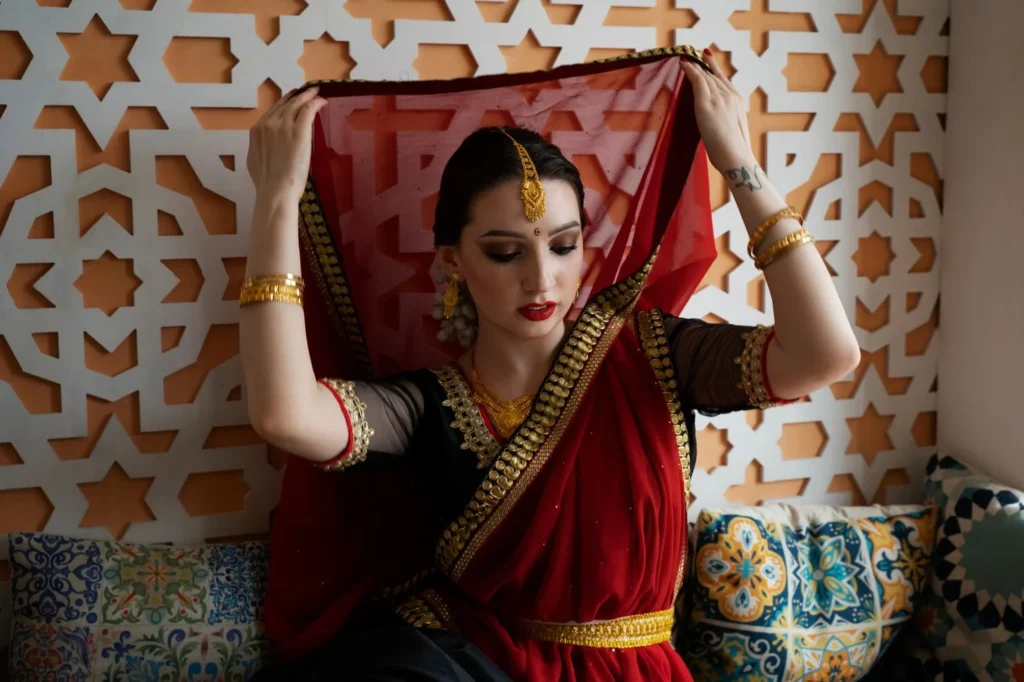Kanchipuram sarees, renowned for their intricate weaving techniques and opulent silk fabric, are steeped in tradition and symbolism. Each sari tells a story of the region’s cultural heritage and the skilled artisans who meticulously craft them. The vibrant colours and mesmerising patterns reflect the diverse tapestry of Indian culture, while the luxurious feel of the silk evokes a sense of elegance and sophistication.
From traditional weddings to festive celebrations, sarees like the tissue kanjivaram saree, Brocade Kanchipuram Saree or the Kalamkari Kanchipuram Saree continue to be cherished as timeless treasures, embodying the grace and beauty of Indian tradition. So, delve into the fascinating history of this cloth, explore their distinctive characteristics, and understand the meticulous process involved in their creation. By the end, you’ll have a deeper appreciation for these timeless treasures.
Rich History of Kanchipuram Sarees
South Indian heritage and culture are deeply entwined with the sari’s legacy. Dating back to the illustrious Chola dynasty, they have adorned the elegant figures of queens and noblewomen, symbolising prosperity and prestige. According to myth and legend, Sage Markanda, revered as the master weaver of the gods, imparted his divine knowledge of weaving to the artisans of Kanchipuram, thus bestowing upon them the skill and craftsmanship to create sari fit for celestial beings. Through centuries of cultural evolution and exchange, the art of Kanchipuram sari weaving has flourished, embracing influences from various dynasties and civilisations. From the intricate motifs inspired by temple architecture to the vibrant colour palettes reminiscent of nature’s bounty, it is a living testament to the region’s rich heritage and artistic legacy.
The Characteristics of Kanchipuram Sarees
The vibrant hues of these pieces reflect the diverse cultural world of South India, with each colour holding its significance and symbolism. Deep reds symbolise prosperity and fertility, while vibrant greens evoke the region’s lush landscapes. Regal blues are reminiscent of the vast expanse of the ocean, symbolising tranquility and strength. Blending these colours results in harmonious combinations, offering a captivating visual experience and honoring the diverse fabric of Indian culture. Furthermore, the intricate designs and motifs adorning thesesarees tell stories of ancient legends, mythological tales, and the beauty of nature. From intricate floral patterns to elaborate geometric shapes, each motif is carefully chosen to convey a deeper meaning and evoke a sense of awe and admiration.
The Making of Kanchipuram Sarees
The journey of crafting sarees like the kanjivaram tissue silk sarees or the Art Silk Saree is a meticulous art form that honors tradition and craftsmanship. Each step in the process, from selecting the finest silk threads to the final weaving, is executed with precision and care. Skilled artisans meticulously handpick the silk threads, ensuring only the highest quality fibers are chosen for the sari. The silk threads undergo dyeing with natural dyes, a skillful process for achieving vibrant and enduring colours. Once dyed, the threads are carefully wound onto spools, ready to be transformed into exquisite sari. The loom, a traditional tool used for centuries, becomes the canvas for the artisan’s creativity.
Kanchipuram sarees are not just garments; they celebrate India’s rich cultural heritage and artistic legacy. With their exquisite craftsmanship, vibrant colours, and timeless elegance, they continue to captivate and inspire women worldwide. Whether it’s the tissue Kanjivaram saree or the traditional Kanchipuram zari sari, each piece is a testament to the skill, dedication, and creativity of the weavers who bring them to life. So, the next time you don a Kanchipuram sari, take a moment to appreciate the centuries-old tradition and craftsmanship that went into making it.






